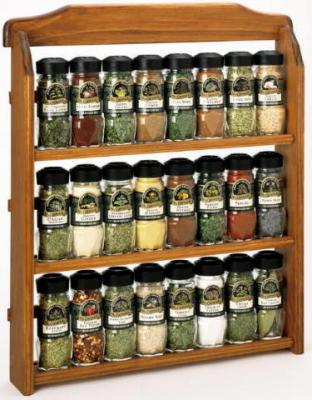How to enhance and improve food flavor
Because taste is such an individual thing, one secret to good cooking is variety. We can all become deadened to taste if we don’t have surprise flavors in our everyday food to add some zip. Take any or all of these ideas and keep them handy in your kitchen. Collect more as you expand your culinary horizons and improve the food flavors in the meals that you prepare and serve.


Procedure Steps
- Garnishes can be a part of the recipe and should always be there to be eaten. Scatter finely chopped parsley or mint across the center of the entrée for a contrast of color and flavor.
- Fresh herbs provide an endless supply of taste variations. Experiment with the pungent flavors of rosemary, thyme and sage, and with the sweetness of tarragon, mint and basil.
- Place paper-thin slices of lemons or limes underneath your ready to eat chicken or fish dishes, or on top when you bake them, then remove before service.
- Use whole baby Greek olives in salads for a contrast away from red tomatoes. Use freshly grated parmesan or Romano cheese whenever possible. The difference is obvious from the first bite.
- Improving food flavor often requires the use of fats. Whole butter, either salted or unsalted, is always superior to margarine. Olive or scented oils with fresh herbs are also the better for flavor over lesser priced oils.
- Cooking with wines and even beers have been in a professional chef’s repertoire for centuries. Think about the color and heartiness of the wine and meats, then match them up. Also, try the lesser used spirits like brandy, sherry, both vermouths, and whisky. When adding to the pan on the stove, let the liquid reduce in volume by half before serving to cook away the bitter alcohol flavor.
- For your next barbeque or tailgate sports party, try cooking hot dogs and sausages in beer instead of water. Beer dogs are a real treat!
- Another chef’s secret so widely used are shallots. They look like garlic cloves, but taste more like sweet onions. Peel and chop or slice finely, then add in the beginning steps for any baking or sautéing meats.
- Purchase two pepper grinders, one for whole black peppercorns, and the other for sea salt. Use these in your kitchen and on the table instead of the ground types. The further a spice is ground down over time, the less flavor it holds. Freshly ground pepper and salt will enhance food flavor instantly.
- Prepare an entire meal al fresco. This is where the dishes are served at room temperature. As it is, the palate of our mouth responds more favorably to foods that aren’t any colder or hotter than the temperature of our bodies. Try freshly sliced tomatoes with balsamic and ground pepper, whole baked chicken picked from the bone, penne pasta salad tossed with fresh cheeses, herbs and olive oil. See for yourself how much improved the food flavor is when it’s served at room temperature!
- Along with shallots and cooking wines, garlic is a staple in any cooks arsenal. Hang a braid of garlic cloves on the wall, and pick one off as needed. Prepare and use the same as shallots. Also, try baking a entire garlic in the oven with one end sliced off and placed face down in a pie pan. Remove when you can squeeze the garlic paste out of its clove and spread onto meats or warm French bread.
- Purchase a citrus zester. This is a tool that is used to peel thin strips of any citrus skin like oranges, lemons or limes. Sprinkle the zest onto salads, meats or vegetables for enhancing food flavor. Store covered in the refrigerator for future use.
- Add any fresh chopped herb to softened butter, such as mint, dill or rosemary. Then roll the butter into a log wrapped in foil or wax paper and put into the freezer. When ready to use, slice off as much as you need and put on top of fish, chicken or steaks just before serving.
Tips
- Don’t be ashamed to ‘steal’ ideas from your favorite restaurants or fellow cooks. Most are happy to share their ideas when you give credit if asked.
- Keep a food inspiration notebook in the kitchen. Use it for menu and recipe clippings and to jot down ideas. This way everything will be in one place and you will have inspiration handy for new ideas when you plan your meals.
- Good cooking is a philosophy. When you go to cook a meal for your friends, family, or even just yourself, enter into your kitchen as if it’s a church. There is no deeper influence on the human body than to feed it because we’re really feeding the life that exists in that body. We nourish it and, thereby, we nourish the soul.
- Think always when buying groceries that the primary goal should be quality and freshness. You can’t make mediocre ingredients any better than they already are no matter what you try to do. Stinky doesn't stop stinking. Good cooking starts always with the best and freshest products you can possibly buy.
- Consider always the psychological impact from the visual appearance of food you serve. When something looks appetizing, you’re halfway there to enhancing the food flavor.
- Certain foods should be eaten at certain times of the year. Fresh tomatoes are tasteless in December, melons and berries explode with sweetness during June and July. The best way to select fresh ingredients at the best price with the most flavor is to follow the seasons.
- Stay open-minded to any ideas that you might have, and experiment without the fear of failure. Inspired creativity comes from your quiet intuition.
What did you think of this tutorial?
+ 1
1 CommentsAdd a Comment
I loved the details provided.




